I Rely on Two or Three Plain Planes
I’ve covered this from time to time but having just flogged off the wood from six bandsawn strip-panels made from 24 spruce studs, and I can tell you that the #4 did the lot with the greatest ease and the best workout a man striving for fitness and aged 71 can get. Furthermore, I might even suggest that anyone doing what I just did would indeed find themselves breathless every five minutes throughout the process. This I cannot get from any machining process. This is the best daylong gym and gym work I have found bar none because I get both the product I want and need at the end plus great physical exercise with legs, torso and upper body synchronised in the whole. Also, I think it is always good to remember that the lighter weight planes mean you can go for a longer period of actual planing, which is what you want for efficiency anyway. I see it as just like backpacking and bike riding, they both work better if you are not carrying any excess weight and who needs to throw a heavyweight plane to take off shavings anyway? Might as well just go to the gym. Saying all of this might seem unnecessary to a reader but you should remember that I plane wood by hand every single day six days a week and have done so for 56 years pretty much full time in my making. I choose this as my way of life and my way of working wood. I don’t shun machines, I don’t have need of them, don’t need the noise and the support stuff that goes with them to make them safe and much much more. If you look back at what I have made over the past few years for woodworkingmasterclasses.com and now sellershome.com you will see that my work is not stymied in any way.
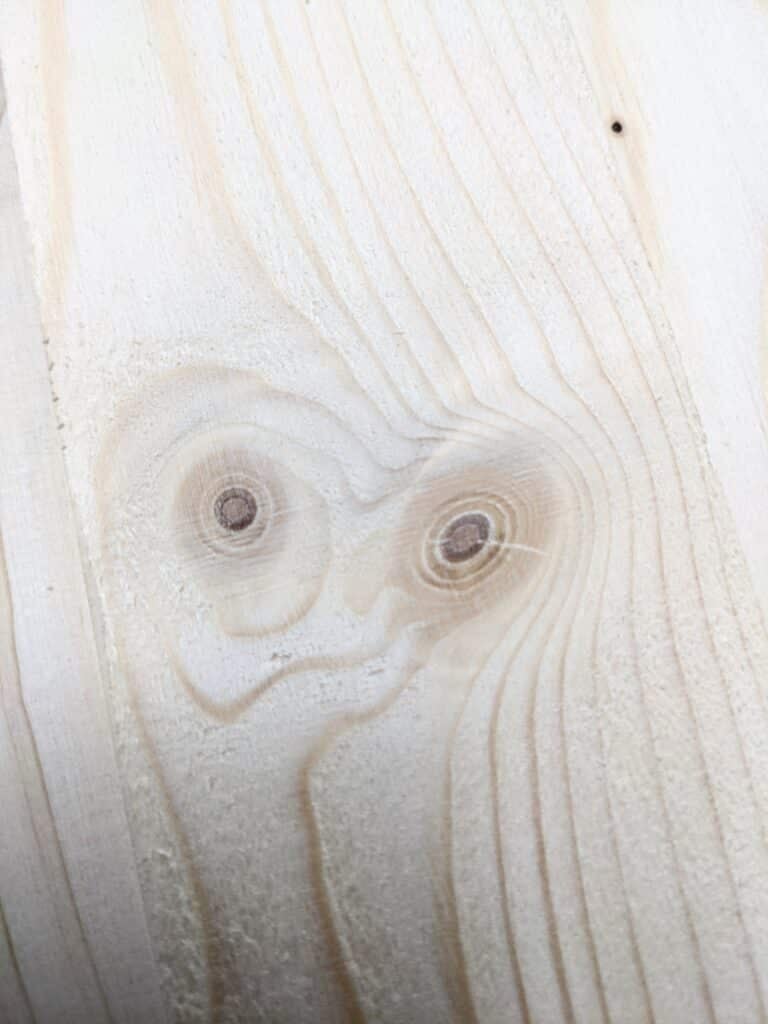
I often hear others say that the number five is best and then the number five and halves, sixes, sevens and eights. I can tell you that this is really far from true. I do understand though that people have preferences according to their exposure. But try to imagine the lives of others. Imagine that you are a 13-year-old woodworker or a 10-year-old version, perhaps you’ve grown elderly and you’re muscle tone is not what it was, a woman with osteoarthritis or you simply have a slighter build. To truly understand, you might deny yourself the luxury of mental logic and consider working with the heavier and bigger, elongated planes at the workbench to see how you really feel and then too to compare the actual outcome. My audience is bigger than the macho-male flashing the big guns and flicking their pec’s for show. Now, I am not opening the debate here so you might resist rising to the challenge. Long planes are not even a luxury, I think that they are simply unnecessary and if you are a maker not a user engineer type, well, you gotta persuade customers so you can indeed make more sales. In my world and from my own experience in my own shop and looking into others, these planes sit for far too long looking impressive on the shelves. I just want my audience to see that you can make just about anything with a #4 plane, you can add in a #5 too. If you do have the added strength and weight to handle their wider versions, the #4 1/2 and the #5 1/2, you will find them hand but not at all essential. The best plane I find that compliments the short Arabian-gelding of planes the #4 is the longer #5 but it is heavier and this added weight is always a consideration for a large percentage of my audience. I quite enjoy owning my #4 1/2 and the #5 1/2 and have owned these alongside my #4 and #5 1/2 throughout my work-life for the slightly extra width they give me and the main reason for this comes to light when I am edge-jointing two side-by-side boards clamped in the vise.
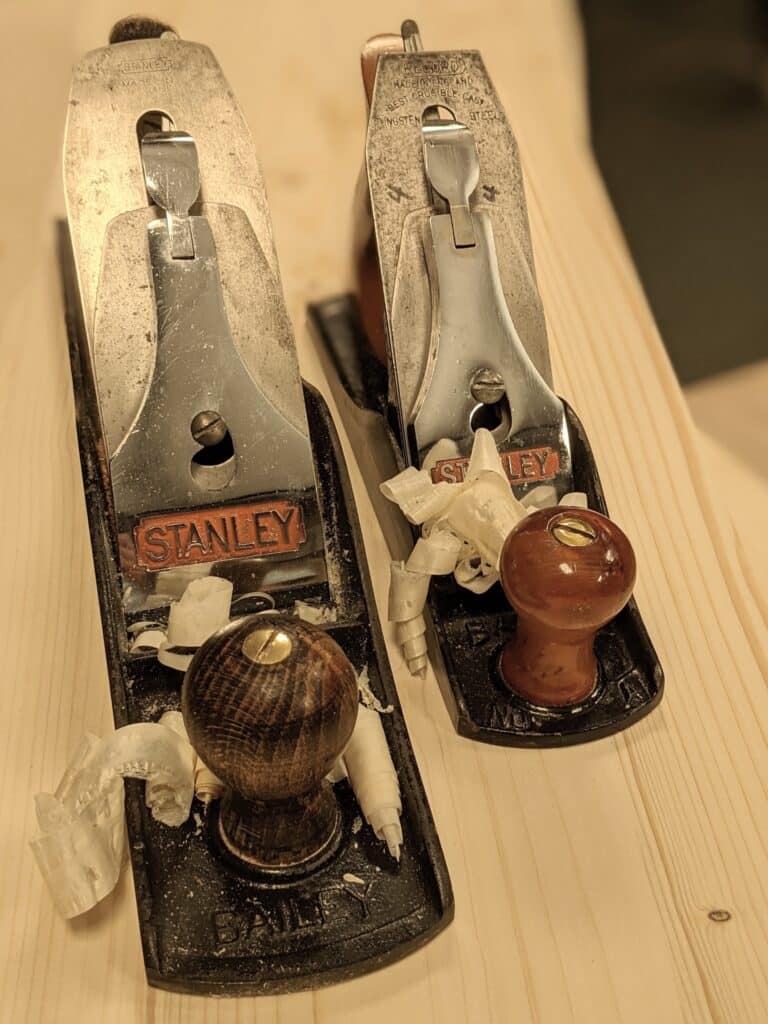
The men I worked alongside throughout my formative years never used any planes that were longer than a jack plane no matter the length of the wood being planed. In my own life, I have only on rare occasions touched, used and put back a longer plane than a jack plane. Now wooden planes are a different matter. In use, you can scarcely feel any weight – that’s what wood on wood gives you. Do I advocate wooden planes to replace the cast metal ones? Nah, not at all. I love the Bailey-pattern bench planes. They are readily available and we can never exhaust the existing stock levels left by their former owner/users. They will last you for your lifetime even if they are third- and fourth-hand to you and better yet you can buy them on eBay for almost nothing at around £30 but sometimes as low as £20 here in the UK at least.
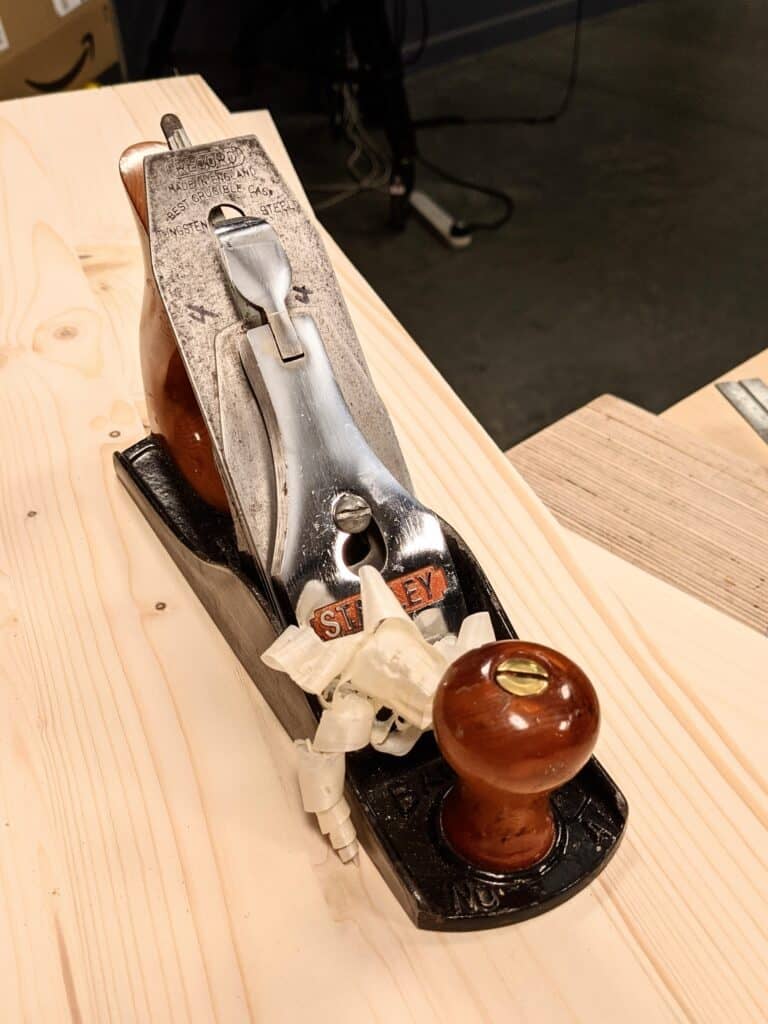
For those with a lighter frame, lower weight and upper body strength and perhaps some who have a disability or two or three, the basic Stanley and Record #4s cannot be beaten. To refurbish one can often take only minutes and then up to an hour usually. I just looked on eBay and there are about a hundred being offered right now in either make.
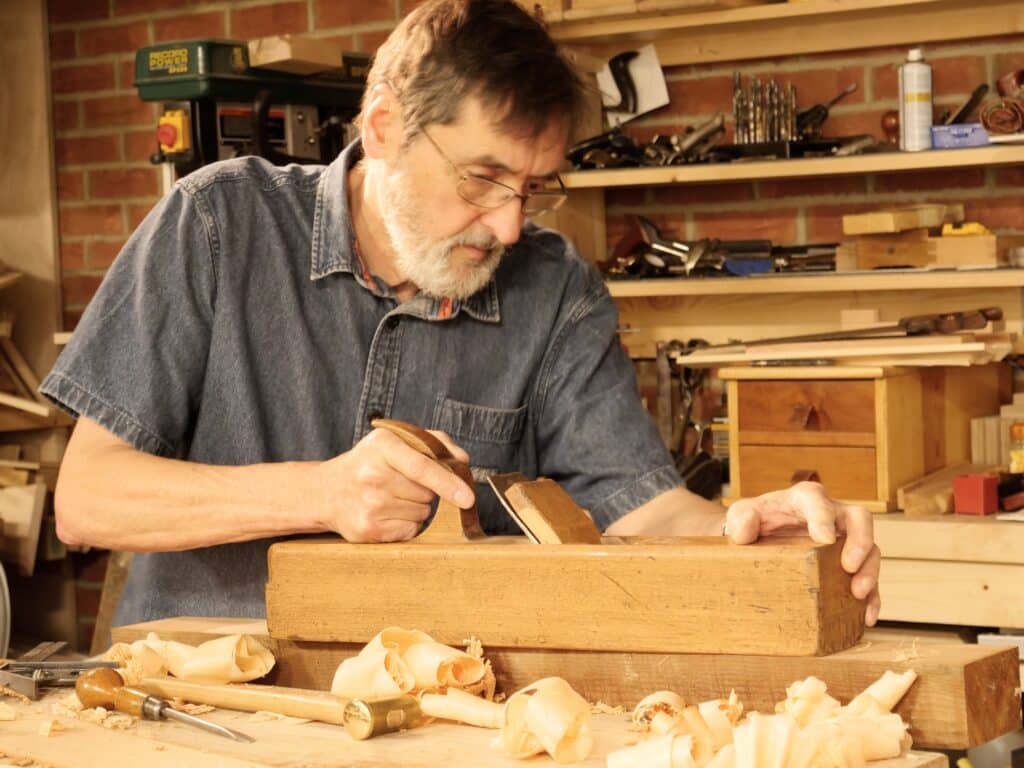
I have considered many finely made planes that are objects of art with regards to creative ability of the engineers. Do planes costing £5,000 serve better than the £25 eBay find? Or do new planes costing £250 offer much greater advantage? Well, no. I think my preference will always be in honour of the Stanley Bailey-pattern bench plane, which of course has been copied for almost a century by other makers. This plane was a remarkable design taking into consideration everything adjustment-wise in relation to the hands pushing it. Singlehandedly, all of the adjustments can be handled in split-second thumb- and finger-tweaks. No modern maker has made any considerable improvement to the 1865 version except in some cases tighter engineering tolerances using better metals, possibly. Does this advantage the user? In my view, no. You can over-engineer a plane and lose what I call the flex of looser thread tolerances. I love that I can simply flick my depth adjustment wheel to spin uptake of thread between clockwise and anti-clockwise directions. It’s fast if I want/need it!
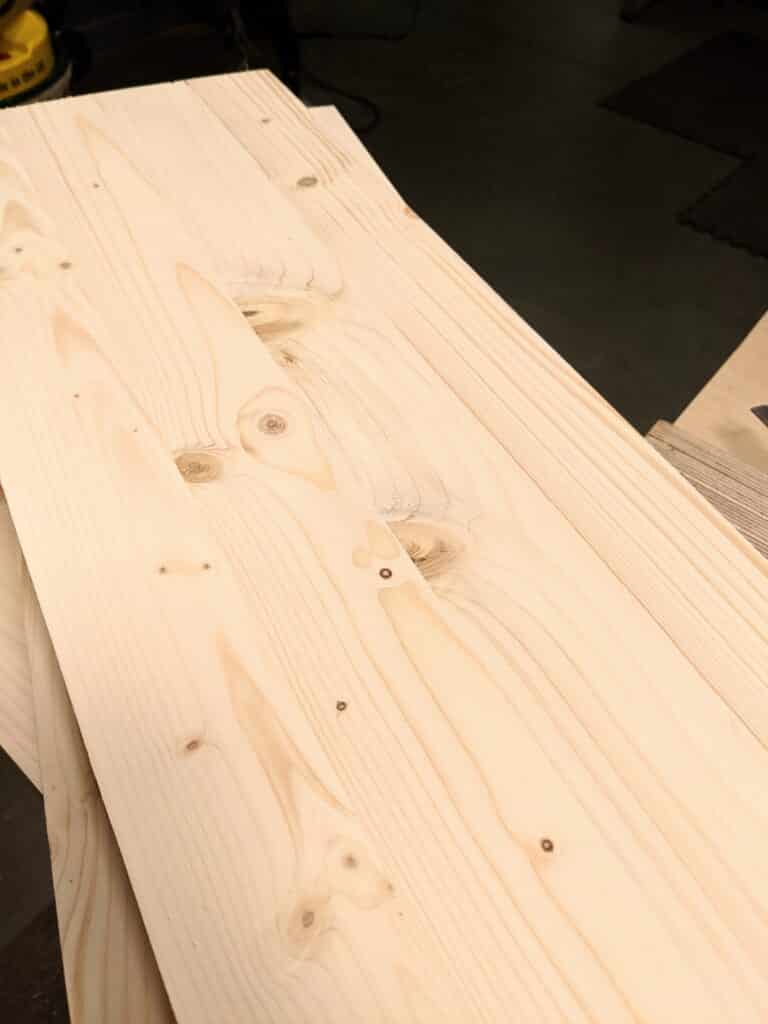
My prototype is coming together and as I complete each of the pieces for our continuing sellershome.com designs I feel a deep sense of satisfaction at one of those simple, unnoticed, unregistered things – I have been using the same Stanley #4 bench plane since I bought it at the start of my 1965 apprenticeship. Throughout the 56 years, I have gone through four cutting irons even though I generally never grind the cutting irons on a mechanical grinding wheel. I wonder, will this current cutting iron see me out at 71? Who knows and who cares? The plane has been a stunning example of a wonderfully amazing design!
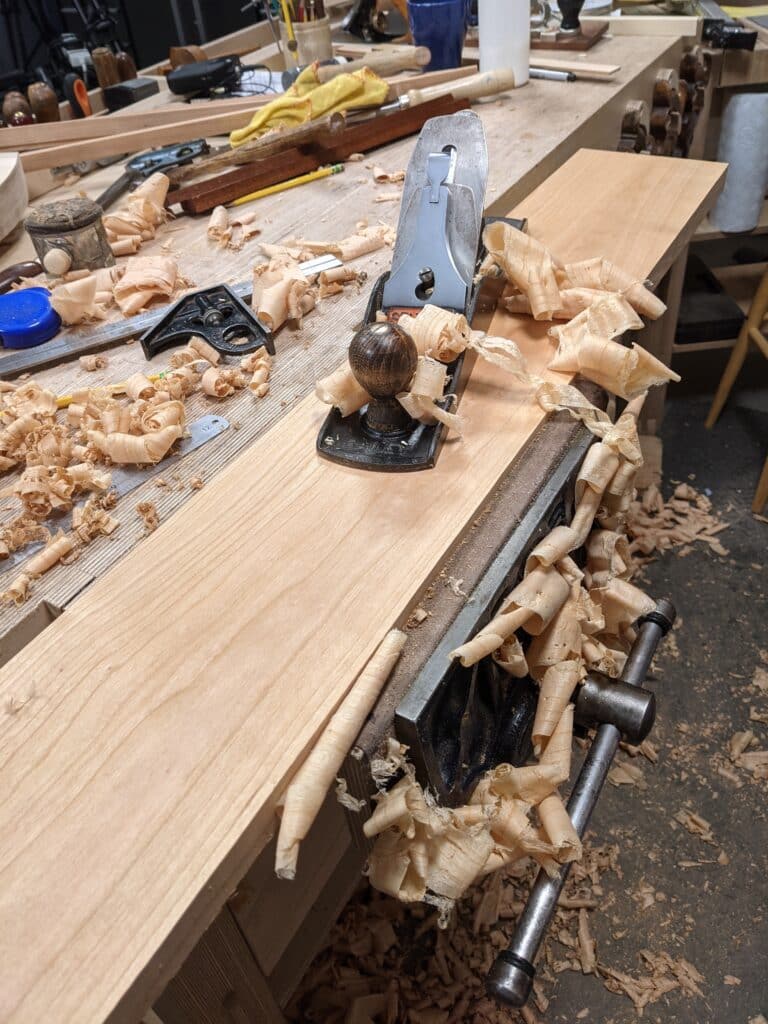
Hardwoods like cherry and oak are very nice to work because of their consistency. Spruce studs are a very uniquely different experience. Those hard knots that jar your strokes every few seconds can be more than just a distraction. But I got there by perseverance and fortitude and I wanted the workout anyway, no matter what. So, I ripped my studs down to 15/16″ on the bandsaw and then I edge-jointed all the joint lines using both a #4 and a #5 or #5 1/2. After glue-up, I surfaced all the 10″ wide, 8′ long boards to level any discrepancies to both sides. Three large bin bags were filled with shavings at the end of the day and there, centre stage, sat my #4. I sharpened all three planes between four and five times throughout the day; that’s more workout working that I did not mind at all.


I bought a second #4 to convert to a scrub, but i find that I like having 2 #4s set differently. I often see Acorn Bailey pattern planes for sale at a much cheaper price. Would one of these work as well as a Stanley scrub?
I have been known to switch between my 5 Stanley’s 2 #4,#4.5, #5 and #5.5 during periods of planing. They still under my bench on top of a removable set of drawers (on casters) that I made.
Acorn never had a good name. You might consider just having a cutting iron and cap iron for a scrub blade to be installed in one of your number 4s or 5s for one thing.
Thanks Paul. wasn’t sure if it was that the big names earned a premium.
I will look out for a blade and cap iron.
i have picked up an Acorn for next to nothing. Felt sorry for it. I can see why it was looked down on
No frog adjustment screw
Pressed plate lateral adjustment
many don’t like the colour scheme, but i like it.
The casting is better than I was expecting, but lighter than a Stanley. Was expecting it to be a poorly finished Stanley reject.
So will fettle it, use it and see what I think.
I agree. I have an Acorn (I think it was my grandad’s – he was a BR fitter and turner) and although I have set up new cheap Draper/Faithfull no. 4s, as well as lots of new and old Record and Stanleys, I just cannot get the Acorn to work. One day I hope to find the geometry to get it planing at least adequately, but at the moment it is resting on the shelf.
As for the jointers, if you lack experience they certainly help get long edges dead straight, but they are very heavy and sometimes difficult to keep level on a thin edge. Paul has the No.4 magic touch, don’t forget!
Look online for articles and videos about making wooden planes. There are loads (and the quality varies, of course). Woodworking magazines also have articles.
I acquired one for very little spent a little time fettling it and it cuts fine. On the Internet i have seen them dismissed as rubbish and others who use them and believe they are better than some suggest. Haven’t used it enough to see how it will work for long term use.
The lateral adjuster looks tinny but works fine. the frog is fiddly to set, due to the lack of an adjusting screw. The painted locking cap does make it look cheap.
The brass adjusting nut is small, but moves easily.
Is it as good as a stanley – no – but it will create shaving with ease.
I have heard it said that to find out about something, buy one, so I did. don’t regret it. Will see in the future which of my number 4s I reach for. perhaps some are regarded badly due to a big difference in quality.
I know where you’re coming from Keith. I have 2 #4s and it was always my intention to make a scrub plane but just kept finding I liked having 2 equals set to go. I then bought another blade and I’ve still not got around to it. Maybe I just don’t really want a scrub. So those and my 5 1/2 will do me fine.
I think you’ve answered a question I’ve always wondered about – what these 4 1/2 and 5 1/2 planes are for. I’ve also got a wooden Marples jack plane I used in the making of the bench (really to find out what they were like without doing any damage). I found it tricky to adjust (but clearly there’s a nack to it) but remarkably smooth and light.
Wider blades, so you can plane more off at once for wider boards. Downside is they require more grunt to move them.
It might be helpful for newcomers to woodworking to know that the Woden and Record versions of the #4 are ever so slightly longer than the Stanley. It means there’s a small but significant amount of extra space between the rear handle and the frog to accommodate your hand. I mention this because I’ve got large hands and a few issues with my wrists, and I find the less cramped hand position on my Woden #4 means my wrists get much less tired and achy. Not true for everyone, I realise, but might be useful information. Likewise the extra weight of a #4 1/2 might be worth it for the extra room.
I love my #4’s, but wish the sole was about 15-20mm longer. Sometimes I bang my hand against the work piece on the return stroke, and the plane pinches the meaty part of my palm so that I am jumping and twisting in agony. I got a #5 1/2 to remedy the situation, but I’ve thought about making a new handle in the style of the panel saws. I am a keyboard warrior, so I don’t have palms like a horse’s hoof. I need protection! 😀
I also find my #7 GREAT for shooting end grain. The momentum is far greater since it is so heavy.
I got a Sargent #6, but I’m leaning towards letting it go. Having the whole pipe organ displayed on the wall looks impressive, but I use my tools – they are not for display and show…
2x #4 for regular use. One with a slight camber – “scrub extra light”, the other set up for very fine smoothing action
A #5 1/2 for edge jointing and certain activities where I need protection
A #7 for shooting (and of course jointing)
A few specialty type planes (plough, router, etc), and I’d say I’m good.
I try to keep my tool smorgasbord as small as possible. I am the one having to keep all those edges sharp and ready to go, and as a weekend warrior, house owner, garden lover, full time employee AND a father of two daughters aged 3 and 5 – shop time is precious.
A neat tip in those cases: when I know that an edge needs sharpening, I place the chisel / iron next to the sharpening station or in the sharpening jig / the training wheels. That way, I can zip out in the shop and sharpen for 10 minutes while Peppa Pig goes on another adventure. After a couple of episodes of Shaun the sheep (da-da-da-daaaa), all my tools are ready to go for the weekend.
PS: I am talking about re-grind or refurbishing, not a quick hone. I do that in 1-2 minutes while working.
I have to say how jealous I am of those of you living on the “other side of the pond”. If I scan ebay UK, there seems to be a much greater selection of vintage tools available at much more reasonable prices. Here in the US trying to find a 4-1/2 or a 5-1/2 at a reasonable price is a bit of challenge (not to mention any kind of specialty plane like a 71). But I am patient and I watch and know that I will eventually find a good deal (and I know that I don’t really “need” one to enjoy woodworking).
For my daughter, on her 9th birthday, I gave her a vintage Stanley #3. For her size I thought was a perfect choice. If she shows interest as she gets older and bigger, I figure a #4 and #5 would provide perfect compliments.
As always, I find the practicality of your comments appealing.
A well-tuned #4 Stanley or Record is a thing of both beauty and reliable performance. With skill, it can be used for almost any task that any bench plane or a block planes addresses.
I also use a #6 Fore plane and a #5 Jack plane set up as a scrub plane. Both are great for initial surfacing, and the #6 is especially nice in a shooting board. I have a #7 but I rarely use it. My #4 1/2 is excellent for finish work and I keep it as sharp as a whisker.
These are just my preferences. Could I get along with a #4 Stanley for almost all the work I do? Absolutely! Though I have to admit, I enjoyed having a #3 for my grandchildren to start with. It was a nice size for them.
Thanks, Paul.
I have to agree that the No.3 is great for kids, mind you I find myself reaching for it sometimes just because I like it. I have one very long plane that I inherited. Rarely use it but I would not part with it for sentimental reasons.
Paul, have you ever built a wooden plane in the traditional way?
I have. I include two moulding planes too. The only thing was I didn’t have a float but it was not hard to make a plane without one.
Thanks for the answer. Last months I started using wooden planes and fell in love with them. During one of my last trip to my favourite lumberyad I found some quatersawn beech 10cm x 10 cm, 1 meter long.
Obviously I bought some pieces thinking about building some wooden planes, so I’m looking around to find advices about plane making
OK. I admit it, I’m a tool junkie/addict. Despite having virtually every plane, chisel and saw Lie-Nielsen has ever made I must agree with Pauls concept. I vary it slightly by basically sleeping with my 5 1/2. It does everything for me except work as a shooting plane or plane end grain. I get around the extra effort required with the wider blade by skewing my 5 1/2 when using it. This shrinks it down to about a number 4 effort. Paul. there are a bunch of us here in Alberta that love your approach to woodworking and follow ( and then build the project) the material you post.Thank you!
Great subject and great advice. It’s so difficult to simultaneously watch great makers on youtube and not buy new tools though! I’ve got a Stanley no.4, which I find a bit on the light side, I’m not sure why but I think it’s because I use my no. 5 wood river plane a lot. I have a German ECE wooden no 7 plane, which is frustrating but fantastic when it works and a fellow ECE wooden no 4 scrub plane which is great on very rough sawn wood, which it blasts through as the iron has a massive camber and is thick steel. The two German planes were decent value I’d say. I need a massive clearout of all my other tools though, if only for my own sanity, then a weekend of cleaning and sharpening and organising!
I have a Stanley#4 handyman, painted blue, from the sixties. Are the older Stanley #4s better than mine? Would my work benefit by getting an older version? Thanks.
I can rarely see a comment, that if somebody uses a #3 as a scrub, but I do and I realized that the 3 is just the same length than my #4, but with a narrower blade. On that blade with a heavy camber gives me much easier cuts than a 50mm blade does, so it is maybe the best one as a scrub. My #5 acts as the general jack after shaping and my #4 with some nice Hock iron is doing the final smoothing. I also use a different blade on that with a 20 degree back bevel for hard woods. Seems like it is working out for me.
Personally, I would not use a #3 because the camber on a number four already works perfectly well and protrudes according to what you set it anyway which of course can match a #3 well enough anyway. I recommend a #78 with a cambered iron for heavy stock removal before adding a cambered iron to a regular #4. That way no additional plane is really needed. I would not recommend anyone buy a Hock iron even if the originals missing; €42/£40 is just far too much for piece of plate tool steel. Such a retro fit is unnecessary as there is no real benefit to it over the standard iron that comes with the plane. Fourthly, there is no need to put back bevels on plane irons either, except perhaps for an awkward patch of grain which can readily be corrected with a #80 scraper anyway. Sorry,Peter, I just disagree. I like to keep things simple.
No-no, its just great to hear your thoughts and I honestly appreciate it! Every word is true 😉 I just happened to have a #3 I did not use for anything and was just sitting on the shelf, turned out to be more useful this way 🙂 The Hock iron was admittedly an impulse buy for my #4 after reading Ron’s book and needed a new blade anyways… It’s just a niche addition, nothing sort of necessary of course 🙂 I rarely use the 65 degree blade, but I had a batch of Tali wood recently I was suffering to plane it smooth, then I decided to give it a try… Turned out to be much better than the simple blade, but still needed the scraper at the end, so maybe you’re right and could just go with the scraper the first place. This is how we learn I suppose 🙂
@Peter Susan. Plane irony…
Ron Hock’s are unnecessarily expensive and very thick.
Is it an American thing to write a book about something you sell? All of a sudden everything we use is rubbish and needs an upgrade. To something more expensive. Thicker. Heavier. How many Stanley blades can you buy for the price of one Hock blade?
There was a time we needed a “French”, “Roubo”, “Continental”, or “Nicholson” bench. A Krenov plane. Water stones. Japanese saws. Depending on what a certain AUTHOR ‘discovered’, based on one (1) tool chest, found in a shed, or one (the same number 1) workbench that looked slightly different, a whole new history of woodworking is reconstructed.
This kind of literature about woodworking is bordering fiction. Great pictures, lovely stories… Build yourself a “Roubo” and a tool chest, filled with the ‘basic 40’ tools that only cost a fortune to do what?
I sometimes wonder what people actually make with their ‘fad-of-the-week” bronze plane with a 1/4 inch thick blade, shiny hardwood bench, and hand-forged holdfasts. I see a lot of wonderful things in the gallery, but nothing that can’t be made with a couple of chisels, a plane and a saw or two.
As another British woodworker once said: “The reason people stop woodworking is because they never really got started. ” It’s never good enough. I have a 1929 Stanley with a sharp iron What can I do to make it better? (Well, I haven’t because I have brand new German wooden planes… chunks of beech with a piece of iron and a wedge) I have been making guitars for over 20 years and not ever once a customer asked about my plane iron. ‘Is my guitar made with an MPV-2X v2.5 blade or just plain iron?’ They ask how I bend the sides if I cut them from a solid piece of wood, … but never if I use the ‘proper’ steel.
Now classical guitar-making is not nearly as complicated as furniture-making: there is only one joint. Well, there are two: a slip joint and a scarf joint. All the rest is something joiners wouldn’t like to do: glueing long grain on end grain and cross-grain, etc… But then again, shouldn’t we just make stuff and not get our heads filled with information that distracts us (on purpose) from what we want to do?
A soundboard is planed to a tolerance of 0.1mm. I use a standard ECE/Kirschen blade in everything. Point at it and it will cut you.
Paul, would a wooden rebate plane do the same job as a 78. Often see good ones for sale.
Thanks for this post. I have a post-war Bailey #4 and a post-war Sargent #5 and nothing else. They seem to work fine for me. I sometimes have been tempted to buy a #7 or #8 for jointing, but then I keep saying that I have never seen Paul Sellers use them, so I may not need them. Thanks for confirming that and saving my money.
I was watching hand tool program awhile ago on public television (I won’t use names).
A guest was speaking about his #4 scrub plane, and made the comment that he only needs to sharpen that plane once per year, and that it doesn’t need to be done any more than that. This was a known woodworker who uses hand tools, and I thought the comment to be odd.
Being relatively new to woodworking, I have at times felt overwhelmed by information and advice, particularly about tools. Like many I watched many, many videos and unfortunately the first that I saw where by (usually American) people like Rob Cosman who advocate *ridiculously* priced tools ($250+ for a saw, around $200 for sharpening stones etc) I almost gave up before beginning. Then I found your videos, thank God. Got myself a 1950s Record no 4 for £20 on eBay, expecting some work to make it serviceable. But the chap who sold it had done it all, even honing the blade. It’s immaculate. And it works like a dream. It’s a shame that people of modest means may be put off (as I almost was) by the large contingent of YouTube influencers who seem more concerned about selling unnecessary stuff than encouraging prospective woodworkers.